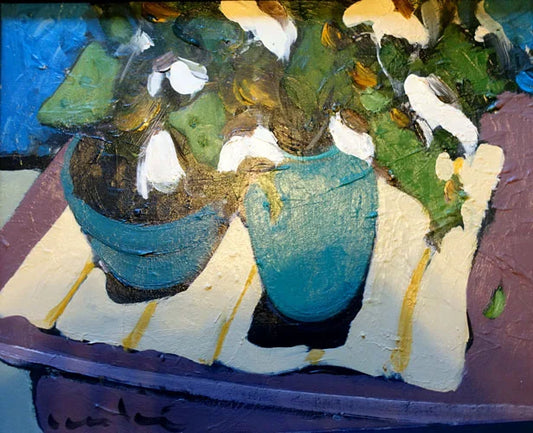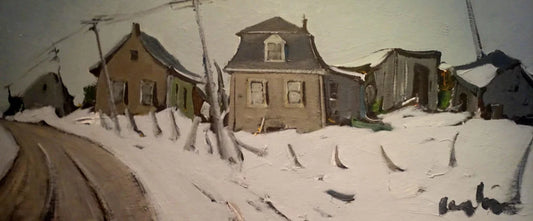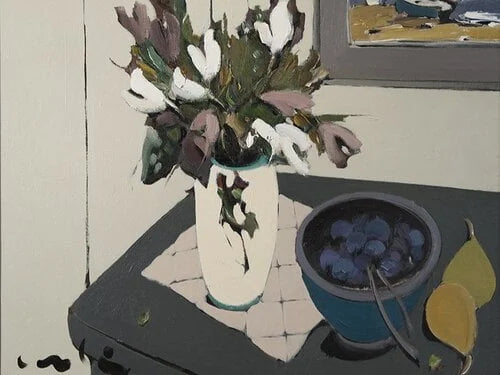Collection: Cantin, Roger
-
Roger Cantin - Untitled / Acrylic/Panel, 11×14 in // 27.94×35.56 cm
Vendor:Galerie NuancesRegular price $0.00Regular price -
Roger Cantin - Untitled / Acrylic/Panel, 27×12 in // 68.58×30.48 cm
Vendor:Galerie NuancesRegular price $0.00Regular price -
Roger Cantin - Untitled / Acrylic/Panel, 24×30 in // 60.96×76.2 cm
Vendor:Galerie NuancesRegular price $0.00Regular price
Request for information
Roger Cantin, a great Quebec painter
Self-taught figurative painter Roger Cantin was born in Quebec City in 1930 (died 2018). He completed his studies at the École des beaux-arts de Québec in 1964 to begin his career as a figurative painter. In his paintings, he uses watercolor and acrylic paint. His works are distinguished by his mastery of space (composition), form (simplicity) and color (use of black, white, blue, green, yellow, ochre often dominated by shades of gray).
A figurative pictorial style
Cantin is a sensitive and reserved artist who immerses himself in the soul of the objects and landscapes he paints. He paints with an inner vision of things, drawing inspiration from his subject rather than copying it. Cantin is particularly fond of Quebec houses, the streets of Old Quebec, interior scenes, landscapes, and still lifes.
"Roger Cantin's painting is a well-kept treasure, as if to protect itself from the prying eyes of overly hasty amateurs. Without being a timid act, his painting expresses, with infinite delicacy, the intimacy of a man who is both calm and worried. The different shades of gray that characterize his approach express this fragility of the being moving through life while trying to avoid shocks. This muted yet very perceptible tranquility hides a lively emotion. In short, Roger Cantin's work deserves to be looked at, caressed with the gaze, to finally reveal the full strength of the craft of this extraordinary painter, out of the ordinary and out of time. Well known for his landscapes and still lifes—built around his finds in flea markets—his art is also enriched by characters, painted with great simplicity and brought to the eye with great tenderness." Robert Bernier
A Quebec painter, Cantin's paintings are part of numerous public and private collections. He is represented by a dozen contemporary art galleries in Quebec.
ADDITIONAL ARTICLE(S):
Roger Cantin (1930-2018 )
For more than three decades now, Roger Cantin's star has shone in the firmament of traditional Quebec figurative painting. Calm, meditative, contemplative, the artist seeks to translate this peaceful state within him through painting. However, it is a relative peace, for beneath this appearance of gentle tranquility lies a certain inner restlessness, a dull anguish, a delicate apprehension of the world. Cultivating his wild, solitary side, Cantin walks the streets of Old Quebec or its immediate neighborhood, in the northern suburbs of Quebec, in search of inspiring objects or points of view. He regularly visits the antique shops on St-Paul Street for the pleasure of discovering old objects that, one day or another, will serve as his models.
The relationship he creates with the objects he collects – teapots, pots, toys, boxes, etc. – is not empty. One only has to observe the artist in the presence of his finds to realize the extent to which the individual is transformed by contact with them: he feels, senses, touches the form, absorbs it, and then, after a moment, his face lights up. The object becomes his, and this, well beyond physical belonging.
In the entirety of figurative pictorial production, a universe largely governed by tradition, Roger Cantin's work stands out in several respects. First, he was able to impose his style, and this, not through careerism, but by force of circumstance. Success came in spite of himself, almost against his will, as enthusiasts and collectors exerted, through their enthusiasm, a pressure that left him little choice. This is how his urban landscapes, these old neighborhoods that come to life under a palette dominated by grays, slowly but surely carved out a place for themselves on the walls of Quebec. The truncated perspectives and the large flat areas that subjugate the gray tones, splitting them or uniting them with the Greek of the creator's inspiration, are all elements of his work that elevate his painting towards that delicate feverishness that constitutes his distinctive mark as an artist.
Cantin does not claim to reinvent painting, nor does he pose as a theoretician. His visual language belongs to the tradition of modernity, which, at the beginning of the 20th century, shed new light on how to translate physical reality. Today, this tradition continues to influence many artists. Cantin has found a register of his own: an expressive base that embodies a dual need to scrutinize the recesses of his memories and to conceive of a world in transit between being and non-being, between darkness and sleepless nights.
Source: Robert Bernier, La peinture au Québec depuis les années 1960, Les Éditions de l’Homme, 2002, Cantin Roger Cantin (1930), pages 302-303.
TO LEARN MORE:
- PARCOURS REVIEW - DEATH OF THE PAINTER ROGER CANTIN (1930-2018)



